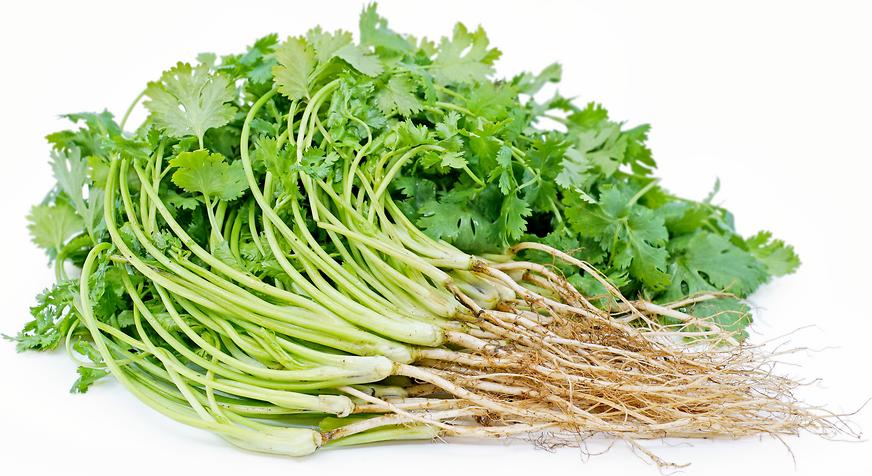


Cilantro Roots
Estimated Inventory, bunch : 0
Description/Taste
Cilantro roots are the roots of the cilantro herb, an entirely edible plant, and have a white central tap root covered in small, dark-brown, hair-like rootlets. The roots of younger plants are thin, moist, and tender, while larger roots from older plants can become tough and somewhat bitter. Cilantro roots offer a pungent, peppery-spiced aroma and flavor, stronger than the leaves, with citrus notes and deep, earthy undertones similar to celery root. Both the texture and flavor will soften when cooked, often developing a mildly sweet finish.
Seasons/Availability
Cilantro roots are available year-round.
Current Facts
Cilantro is an herb botanically classified as Coriandrum sativum and is a member of the Apiaceae, or parsley family. It is also commonly known as Coriander or Chinese parsley. Its scientific name is derived from the Greek word “koris,” meaning stink bug, and was likely inspired by the strong smell that cilantro plants produce when crushed or bruised. Cilantro’s unique flavor has become somewhat notorious for its polarizing effect, as many people are inherently inclined to dislike the taste, thanks to a rare gene that allows them to detect natural aldehyde chemicals in the plant. Aldehydes are also found in soap; hence, those naturally cilantro-averse often claim that the herb tastes like soap or toothpaste.
Nutritional Value
Cilantro roots are rich in antioxidants and anti-inflammatory properties. They are a good source of vitamins A, C, and K and offer trace amounts of folate, potassium, and manganese. Thanks to its nutritional makeup, it has been studied for its ability to promote heart health, energy, and healthy hair and skin.
Applications
Cilantro roots are best used in cooked applications, although the young, tender roots can be finely chopped and used to garnish dips, soups, or salads. Young Cilantro roots may also be stir-fried with minimal cooking, while older, larger coarse roots are best suited for longer cooking applications, such as in broths and stocks. Larger roots stand up to long-simmering times and high temperatures, unlike the leaves, and will also soften and become more palatable over time. Cilantro roots are commonly used in Thai cuisine and are a main ingredient in curry paste, though their flavor also works well in some Mexican dishes, notably ones that include beans, cheese, fish, or eggs. Their strong, peppery, citrusy-spiced flavor can be tempered when cooked with Thai peppercorns, garlic, and salt. Cilantro roots also pair well with chiles, carrots, scallion, tomato paste, coconut milk, citrus, ginger, kaffir lime leaves, galangal, lemongrass, and meats like chicken or lamb. Whole cilantro roots can be stored in a sealed bag in the freezer for a couple of months.
Ethnic/Cultural Info
While the leaves and seeds of the Cilantro plant are commonly found in kitchens worldwide, Cilantro roots are primarily used in Asia and are a prevalent kitchen staple in Thai cuisine. Locally known as rak phak chi, Cilantro roots are essential to making an authentic Thai curry, and they are one of the primary components of many Thai seasoning pastes, dips, and marinades, alongside garlic, chiles, salt, and Thai peppercorns. They are also famously featured in the marinade for gai yang, or Thai grilled chicken, a dish found throughout Thailand with various twists, depending on the region.
Geography/History
Cilantro is native to Southern Europe, Southwest Asia, and North Africa and is one of the oldest herbs in the historical record. Cilantro seeds have been found in ruins dating back to 5000 BCE, and the plant itself was mentioned in the bible and ancient Sanskrit texts. It spread throughout Europe and Asia via trade routes and was eventually introduced to the Americas in the 1600s. Today, it’s cultivated worldwide but prefers climates with cool, dry summers. It is a hardy annual herb that is easy to grow and has become popular for home herb gardens. Cilantro roots are rare in comparison to the leaves and seeds, but they can be found at Asian marketplaces, specialty stores, or farmers markets.
Recipe Ideas
Recipes that include Cilantro Roots. One




